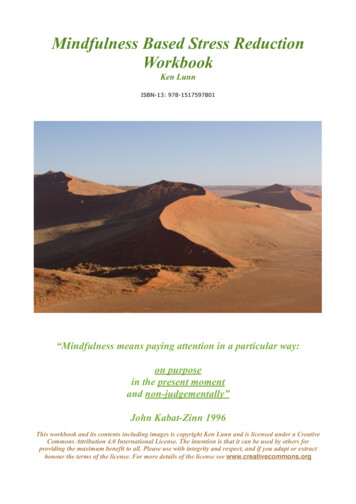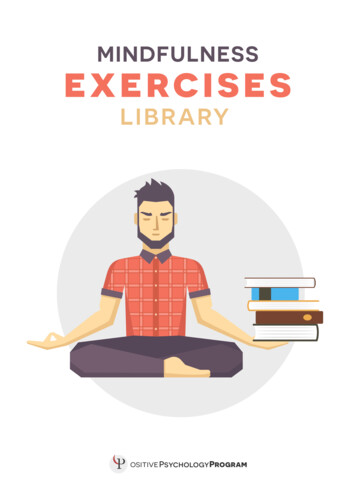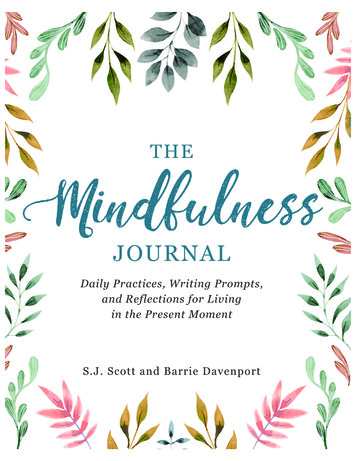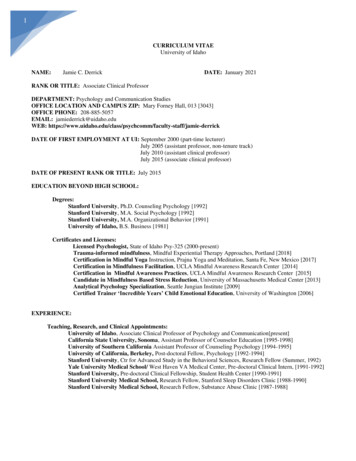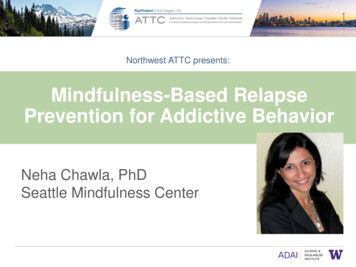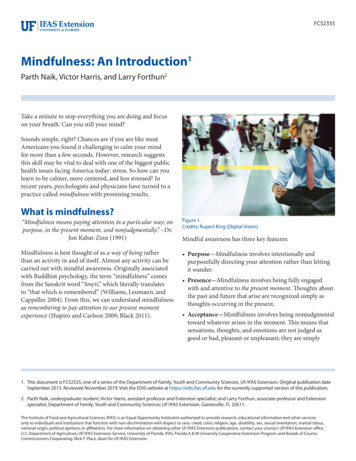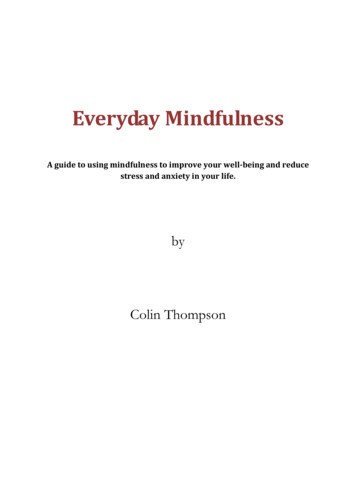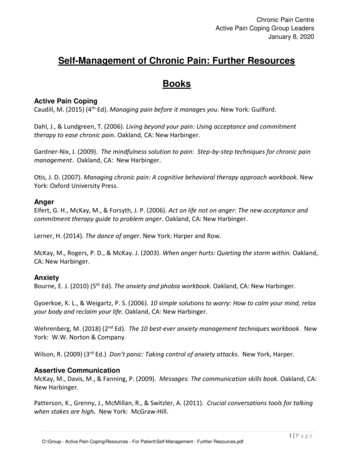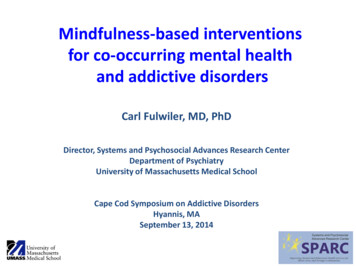
Transcription
Mindfulness-based interventionsfor co-occurring mental healthand addictive disordersCarl Fulwiler, MD, PhDDirector, Systems and Psychosocial Advances Research CenterDepartment of PsychiatryUniversity of Massachusetts Medical SchoolCape Cod Symposium on Addictive DisordersHyannis, MASeptember 13, 2014
ASAM Disclosure of Relevant Financial Relationships27th Annual Cape Cod Symposium on Addictive DisordersPresentation: Mindfulness-based interventions for cooccurring mental health and addictive disorders9/13/14NameCarl alFinancialRelationships: Relationships:What WasFor What RoleReceivedNo RelevantFinancialRelationshipswith AnyCommercialInterestsX
Emotion dysregulation in mental health andaddictive disordersWhat is mindfulness and how is it used intreating mental disorders and addiction?Overview of the core elements ofMBCT & MBRP and how they differHow does it work?
Emotion regulation deficitsWerner & Gross (2009)In Kring & Sloan (Eds) Emotion Regulation and Psychopathology. Guilford , NY Mood and anxiety disorders, borderline and antisocialpersonality disorders, PTSD, alcohol and drug use disorders Nearly 200 DSM diagnoses involve emotion dysregulation
Fad or breakthrough?
Habits of mind and behaviorAuto-pilotMulti-taskingPast Future
A definition of MindfulnessThe awareness that emerges from paying attentionon purpose and non-judgmentallyto the unfolding of experience from moment tomomentAdapted from Jon Kabat-Zinn, 2003
Mindfulness Focused Attention Open MonitoringFocused attention – directing and sustaining attentionon a chosen object, noticing when mind wanders –disengaging and redirecting to object of attentionOpen monitoring – non-directed, non-reactivemoment to moment awareness of all aspects ofexperienceLutz, et al Trends in Cognitive Sciences 2008
Models of clinical interventionsDialectical Behavior Therapy (DBT) andAcceptance and Commitment Therapy (ACT): CBT-based with training in mindfulness skills Mindfulness one component among several Guided exercises vs. formal meditation
Models of clinical interventionsDialectical Behavior Therapy (DBT) andAcceptance and Commitment Therapy (ACT): CBT-based with training in mindfulness skills Mindfulness one component among several Guided exercises vs. formal meditationPractice is at the core of MBSR, MBCT, MBRP: Teaching formal meditation practices Daily practice 30-45 min. Teachers have extensive personal practice &formal training in retreat setting
Mindfulness-Based Stress Reduction
JAMA Intern Med. 2014 Jan 6. doi: 10.1001/jamainternmed.2013.13018
Goyal et al. 2014 – Methods Databases searched: MEDLINE, PsycINFO, EMBASE,PsycArticles, Scopus, CINAHL, AMED, Cochrane Library Tools used: Systemic review software; random-effectsmeta-analyses using standardized mean differences(effect size [ES]; Cohen d) Only included RCTs with active control groups Excluded studies in which meditation was not thefoundation – yoga, tai chi, ACT, DBT 18, 753 citations title-abstract reviewed, 1,651 full-textarticles reviewed - 47 trials (N 3515) metinclusion/exclusion criteria
Goyal et al. 2014 – ResultsMindfulness meditation programs had moderateevidence of improved anxiety, depression and painOutcome8 weeksRange3-6 ssion0.30[0.00-0.59]0.23[0.05-0.42]Pain0.33[0.03- 0.62]
Goyal et al. 2014 – ResultsMindfulness meditation programs had moderateevidence of improved anxiety, depression and painOutcome8 weeksRange3-6 ssion0.30[0.00-0.59]0.23[0.05-0.42]Pain0.33[0.03- 0.62] Insufficient evidence of effect on substance use* No evidence mindfulness better than active treatment(drugs, CBT and other behavioral therapies)
Mindfulness-based cognitive therapy for depression
Depression The leading cause ofdisability in the U.S. forages 15-44 2nd leading cause ofdisability worldwideWHO The Global Burden of Disease, 2008NIMH Statistics, http://www.nimh.nih.gov/statistics/1MDD ADULT.shtml
Depression treatment outcomes andrecurrenceMajority have incomplete response, non-response,recurrence, or drop out of treatmentWith each recurrence likelihood of future recurrenceincreasesAlternatives to long-term antidepressant medication?
Emotional reactivity and RelapseSegal et al. (2006) Archives of General Psychiatry
Survival Analysis12/40 30%32/47 68%
Improved depressive symptomsand quality of lifeControlsMBCTGodfrin & van Heeringen , Behaviour Research and Therapy 48, Iss 8 2010 738 - 746
27%28%71%Segal Z, et al. Arch Gen Psychiatry. 2010 Dec: 67(12):1256-64
Emerging evidence for efficacy of MBCT for currentepisodes of depressionGeschwind 2012 Br J Psychiatry– N 130 randomized to MBCT vs. TAU– Reduction in depression scores greater with MBCT:30-35% improvement vs. 10%, p .001van Aalderen 2012 Psychol Med– Subjects with recurrent depression randomized toMBCT TAU (n 102) or TAU alone (n 103)– MBCT as effective for patients who were currentlydepressed as for patients who were in remission
Addiction like major depression – a chronic,relapsing condition
Mindfulness-Based Relapse Prevention (MBRP) Mindfulness practices with relapse preventionskills training Patterned after Mindfulness-Based CognitiveTherapy (Segal et al. 2002) Group format, 8 weekly 2-2.5 hr. sessions Daily home practice w/ CD Aftercare or post-detoxification/stabilization
Goals of MBRP Increased awareness of triggers and habitualresponses
Goals of MBRP Increased awareness of triggers and habitualresponses Cultivate present moment awareness and skillfulresponses to decrease likelihood of relapse
Goals of MBRP Increased awareness of triggers and habitualresponses Cultivate present moment awareness and skillfulresponses to decrease likelihood of relapse Observe unpleasant thoughts and feelings andaccept them without judgment
Goals of MBRP Increased awareness of triggers and habitualresponses Cultivate present moment awareness and skillfulresponses to decrease likelihood of relapse Observe unpleasant thoughts and feelings andaccept them without judgment Change our relationship to discomfort, learning torecognize challenging emotional and physicalexperiences and responding to them in skillful ways
Goals of MBRP Increased awareness of triggers and habitualresponses Cultivate present moment awareness and skillfulresponses to decrease likelihood of relapse Observe unpleasant thoughts and feelings andaccept them without judgment Change our relationship to discomfort, learning torecognize challenging emotional and physicalexperiences and responding to them in skillful ways Build a lifestyle that promotes mindfulness practiceand recovery
Research on MBRP – Populations studied Adults in outpatient treatment Adults who recently completed detox orintensive outpatient treatment Incarcerated adults with a history of substanceabuse Smokers
Research on MBRP:First RCT – Pilot feasibility study (Bowen et al 2009) N 168 from community treatment facilitiesAvg. age 40; 71.5% male; 42.1 % ethnic/racial minorityMBRP vs. RP post-intervention (detox or IOP) vs. TAUPre-post, 2 and 4 month outcomes54% reporting regular meditation practice at 4-monthfollow-up – 4.7 d/wk, 30 min/session 4 month outcomes: days of use 2.1 vs. 5.4 (p .02)Bowen,S., et al. (2009) Subst Abus. 2009 ; 30(4): 295–305
Research on MBRP: Full-scale RCT (Bowen 2014) RCT N 286 from community treatment facilitiesAvg. age 40; 71.5% male; 42.1 % ethnic/racial minorityMBRP vs. RP post-intervention (detox or IOP) vs. TAU6 and 12 month outcomesBowen,S., et al. (2014) JAMA Psychiatry 71(5):547-556
Research on MBRP: Full-scale RCT (Bowen 2014)6 months: MBRP & RP significantly longer time to first druguse and heavy drinking (vs. TAU) Significantly fewer days of drug use12 months: MBRP significantly fewer days of drug use (vs.RP/TAU) Significantly lower probability of heavy drinking* Self-report largely confirmed by drug screensBowen,S., et al. (2014) JAMA Psychiatry 71(5):547-556
Common elements of MBSR/MBCT/MBRPSwitch out of: Automatic pilot Avoidance Thinking about Judging and fixing Reactivity Unhealthy habitsTo: Awareness; Intentional mode Curiosity and acceptance Directly experiencing Non-doing and being Skillful responding Taking care of ourselves andstaying well
/MBCT/MBRPClass structure: Guided practice Inquiry Worksheets, handouts, homeworkTeaching style: Embodied mindful presence – awareness,acceptance, compassion – reflects personal practice Experiential teaching emphasizes investigatingexperience directly Inquiry focuses on present-moment experience vs.story-telling and interpretation
Common elements of MBSR/MBCT/MBRPInquiryThis requires the instructor to sharpen his/her ability to listen closely, allowspace, refrain from the impulse to give advice, and instead, to inquire directlyinto the actuality of the participant’s experience.”Jon Kabat-Zinn, Santorelli 2005Three layers of inquiry(Crane, R. 2009)NOTICING: Observing thedirect experienceDIALOGUE: Exploring the effectsof bringing awareness to directexperienceLINKING: Exploring how theselearnings relate to ways of beingwith inner and outerexperiences in daily life
Common elements of MBSR/MBCT/MBRPFormal practices: Body scan Mindful movement/yoga Walking meditation Mindfulness of breath/body/sounds/thoughtsInformal practices: Mindfulness of daily activities Moment to moment awareness
Practice, practice, practice –Formal meditation practice mediates improvementCarmody & Baer (2008) J of Behav Med
Cultivating awareness of the link betweenactivity and moodExcessive focus on work or other stressors,gradually giving up of activities that we enjoy and nourish us,depletes our energy and resources and leaves us vulnerable torelapseSegal, Williams and Teasdale 2013 (adapted from M. Asberg)
MBCT Sessions1. Awareness and automatic pilot2. Living in our heads3. Gathering the scattered mindDevelopingAwareness
MBCT Sessions1.2.3.4.5.6.Awareness and automatic pilotLiving in our headsGathering the scattered mindRecognizing aversionAllowing and letting beThoughts are not factsDevelopingAwarenessTurning towardthe unpleasant
MBCT Sessions1. Awareness and automatic pilot2. Living in our heads3. Gathering the scattered mind4. Recognizing aversion5. Allowing and letting be6. Thoughts are not factsDay of practice7. How can I best take care of myself?8. Maintaining and extendingnew learningDevelopingAwarenessTurning towardthe unpleasantStaying well,taking actionwhen mood islow
MBRP Sessions1. Automatic pilot and relapse2. Awareness of triggers and craving3. Mindfulness in daily lifeAwareness
MBRP Sessions1.2.3.4.5.6.Automatic pilot and relapseAwareness of triggers and cravingMindfulness in daily lifeMindfulness in high-risk situationsAcceptance and skillful actionSeeing thoughts as thoughtsAwarenessMindfulness& relapse,acceptance
MBRP Sessions1. Automatic pilot and relapse2. Awareness of triggers and craving3. Mindfulness in daily life4. Mindfulness in high-risk situations5. Acceptance and skillful action6. Seeing thoughts as thoughtsDay of practice7. Self-care and lifestyle balance8. Social support and continuingpracticeAwarenessMindfulness& relapse,acceptanceStaying well
Informal practicesMBCT: 3 step breathing space 3 step breathing space with difficultyMBRP: S.O.B.E.R. breathing space Urge surfing
S.O.B.E.R. Breathing spaceS Stop: pause wherever you areO Observe: what is happening in your body & mindB Breath: bring focus to the breath as an ‘anchor’ tohelp you focus and stay presentE Expand awareness: to your whole body &surroundingsR Respond: mindfully vs. automatically
Integrating Mindfulness and 12 Steps
Integrating Mindfulness and 12 StepsAdmitted we were powerless over alcohol Awareness that we are suffering – that we are the cause of ourown suffering and have caused suffering in others
Integrating Mindfulness and 12 StepsAdmitted we were powerless over alcohol Awareness that we are suffering – that we are the cause of ourown suffering and have caused suffering in othersCame to believe that a Power greater than ourselves couldrestore us to sanityAccessing deep inner sources of wisdom that we share with allbeings
Integrating Mindfulness and 12 StepsAdmitted we were powerless over alcohol Awareness that we are suffering – that we are the cause of ourown suffering and have caused suffering in othersCame to believe that a Power greater than ourselves couldrestore us to sanityAccessing deep inner sources of wisdom that we share with allbeingsDecided to turn if over to a higher powerLetting go of delusions of control, following a wisdom path withan ethical foundation of generosity, compassion and lovingkindness
How does it work?
Meditation experience is associated withincreased cortical thickness in specific areasSomatosensorycortexR. anteriorinsulaBrodmannarea 9/10Lazar et al. NeuroReport, 16, 1893-97, 2005
8-week MBSR training results in lasting changes inthe brainBefore4 monthsDavidson, et al. Psychosomatic Medicine 65(4):564-70, 2003
Sadness provocationelicits:a) neural activation inmidline self-referentialprocessing areas,b) deactivation invisceral & somaticprocessing areas
Mindfulness training reduces neural reactivityReduceddeactivation(red MT control)Reducedactivation(blue Control MT)Farb et al., 2010
Emotion regulation pathways
Resting state fMRI provides a measurement offunctional brain connectivitySeed 1500100050100150500050100150200Correlation between seed ROIand other voxels200
Amygdala-orbitofrontal functional connectivity isinversely related to trait differences in angerFulwiler, Zhang and King 2012, Neuroreport 23(10):606-10
MBSR training changes amygdala functionalconnectivity
Second sample: increased amygdala-prefrontal andamygdala-insula connectivityInsulaAnterior InsulaDorsolateral PFC
Conclusions To deliver a mindfulness-based intervention withfidelity, the teacher/therapist should have their ownpractice
Conclusions To deliver a mindfulness-based intervention withfidelity, the teacher/therapist should have their ownpractice Rigorous clinical trials have demonstrated theeffectiveness of mindfulness for depression, anxietyand prevention of relapse to addictive disorders
Conclusions To deliver a mindfulness-based intervention withfidelity, the teacher/therapist should have their ownpractice Rigorous clinical trials have demonstrated theeffectiveness of mindfulness for depression, anxietyand prevention of relapse to addictive disorders Improved emotion regulation achieved throughsustained meditative practice depends on changes inthe brain’s emotion regulation circuitry
Conclusions To deliver a mindfulness-based intervention withfidelity, the teacher/therapist should have their ownpractice Rigorous clinical trials have demonstrated theeffectiveness of mindfulness for depression, anxietyand prevention of relapse to addictive disorders Improved emotion regulation achieved throughsustained meditative practice depends on changes inthe brain’s emotion regulation circuitry A mindfulness approach is compatible with the 12steps
Additional informationMBSR UMass Center for Mindfulnessumassmed.edu/cfmMBCT Oxford Mindfulness Centeroxfordmindfulness.orgMindfulness-Based Relapse Preventionmindfulrp.comProfessional training in MBCT and MBRP UCSD Professional Training Inst.mbpti.org Omega Inst., Rhinebeck NYeomega.org12 steps and Mindfulness Kevin Griffin Thérèse Jacobs Stewart Buddhist Recovery ry.org
Copy of presentation:umassmed.edu/sparc - Publications and Products - Presentations - iler@umassmed.edu
3. Mindfulness in daily life 4. Mindfulness in high-risk situations 5. Acceptance and skillful action 6. Seeing thoughts as thoughts Day of practice 7. Self-care and lifestyle balance 8. Social support and continuing practice Awareness Mi
